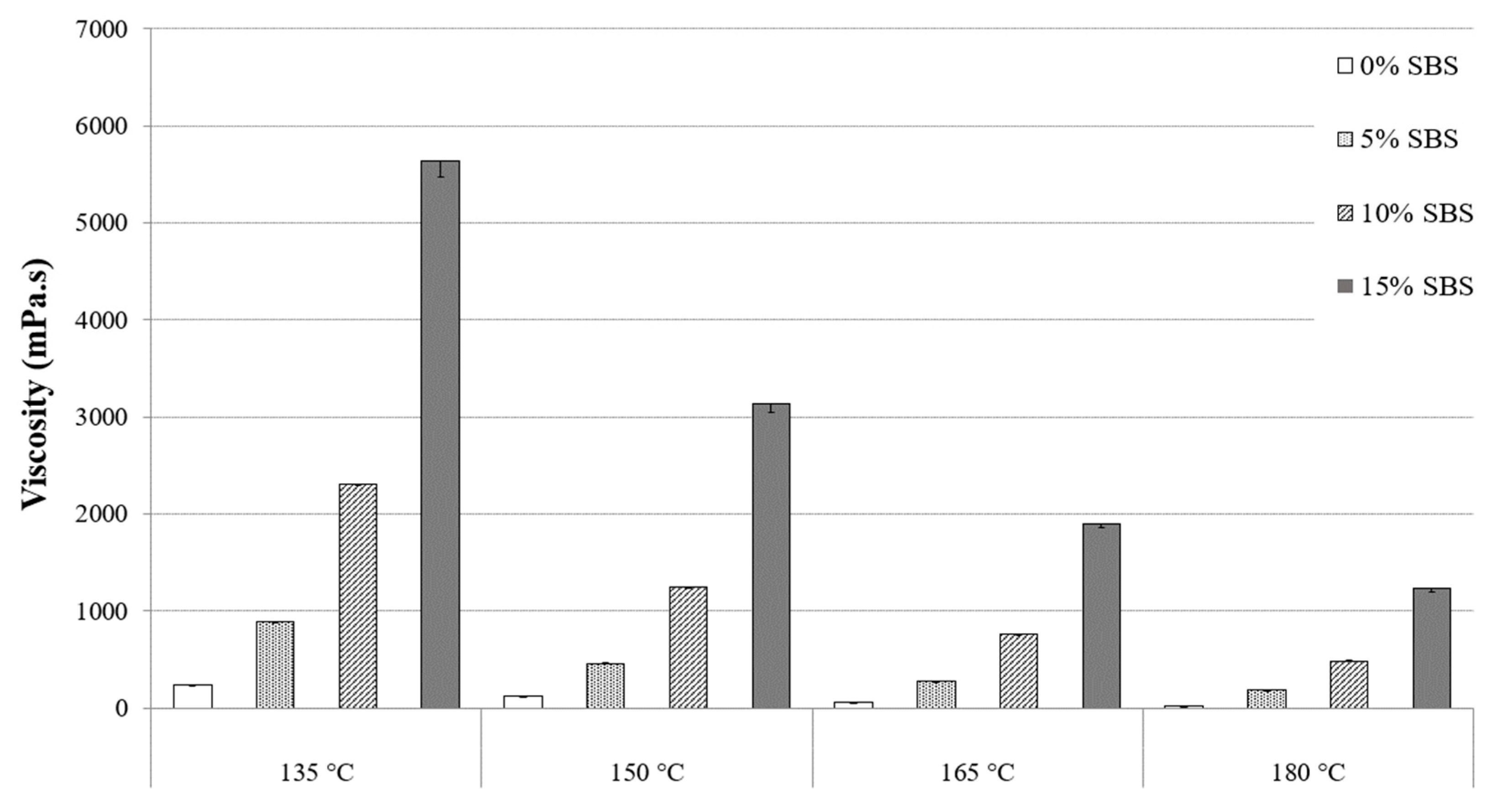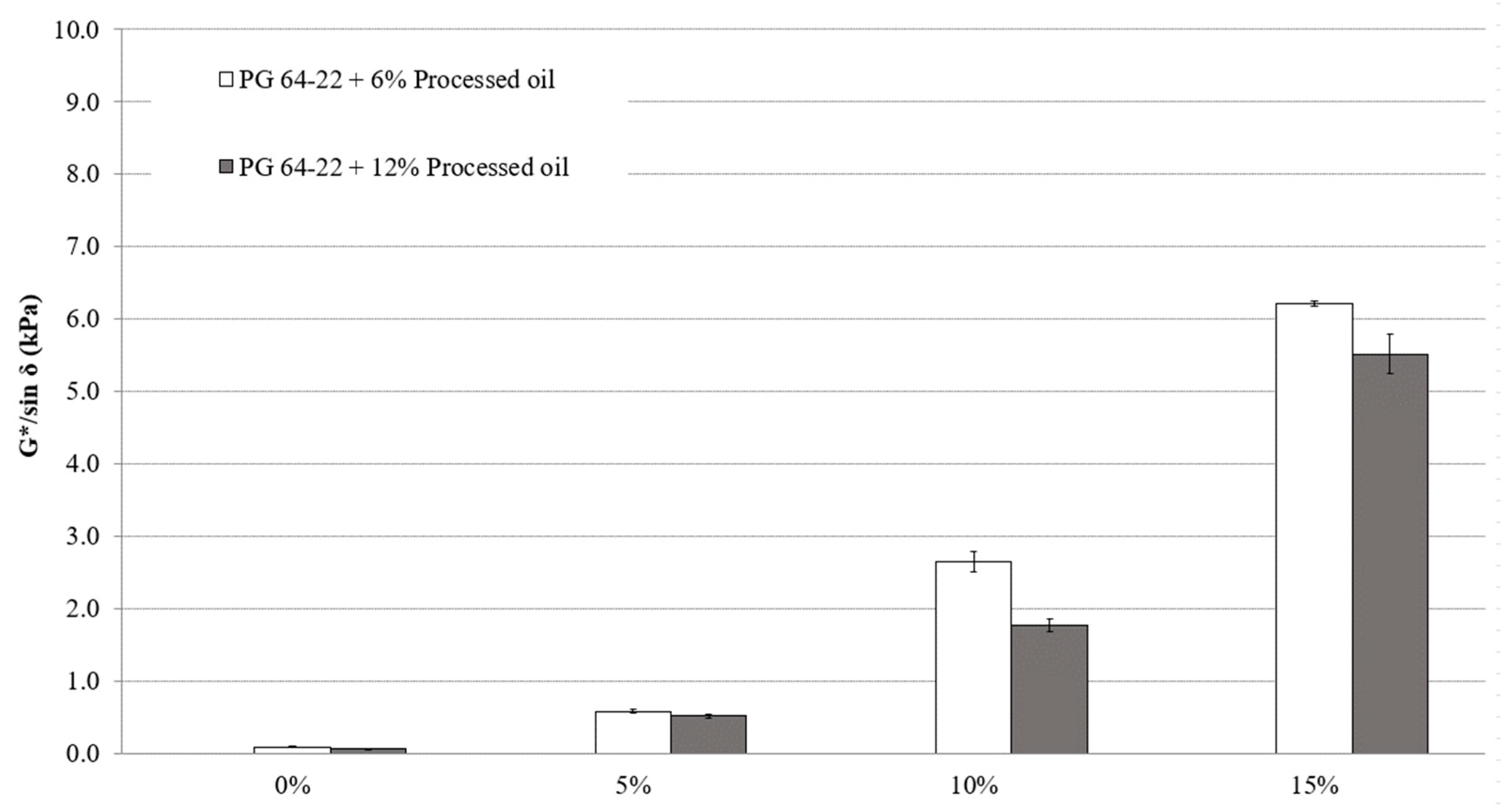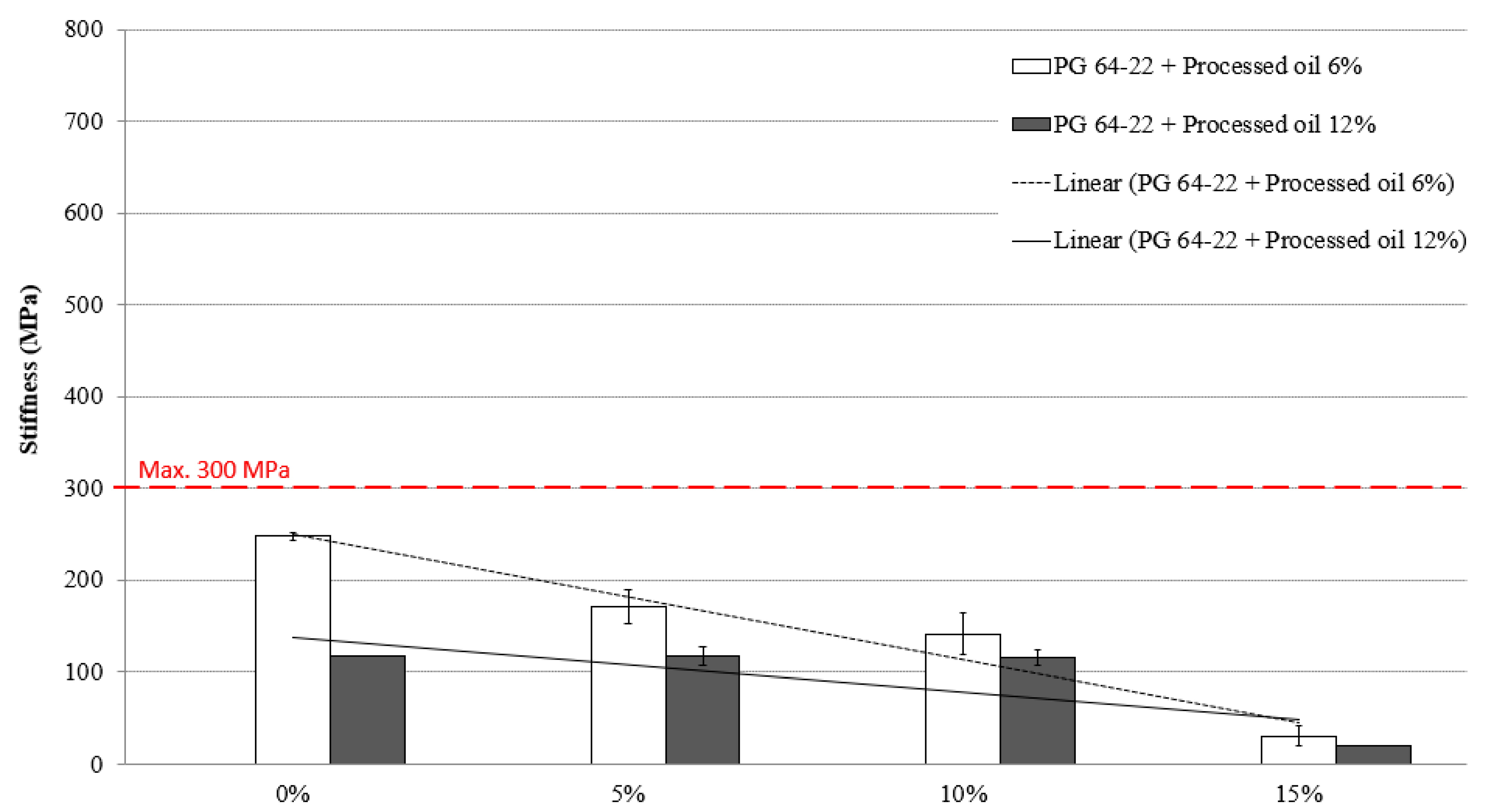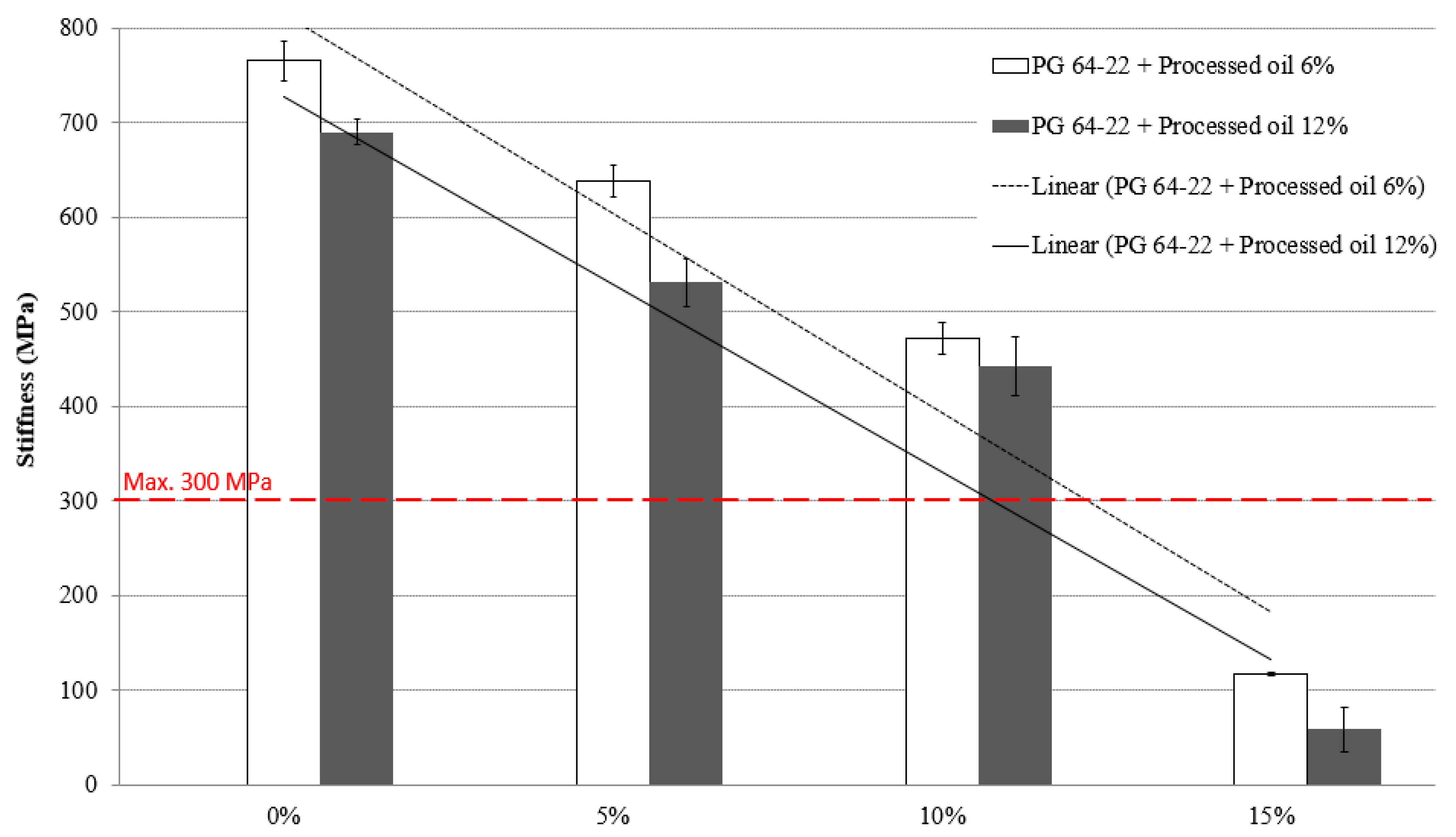Laboratory Evaluation of Asphalt Binders Containing Styrene-Butadiene-Styrene (SBS) and Processed Oil
Abstract
:1. Introduction
2. Experimental Design
2.1. Materials
2.2. Production and Preparation of SBS-Processed Oil-Modified Asphalt Binder
2.2.1. Basic Characteristics Tests
2.2.2. Statistical Analysis Method
3. Results and Discussion
3.1. Rotational Viscosity
3.2. Rutting Properties
3.3. Fatigue Cracking
3.4. Low-Temperature Cracking Properties
4. Summary and Conclusions
- The addition of processed oil in concentrations of 6% and 12%, combined with different SBS concentrations, decreases the viscosity values of the asphalt binders, improving their handling and workability. This is due to the restructuring of asphaltene nano-aggregates molecules at high mixing temperatures resulting from processed oil addition during modification
- While the addition of SBS increases the viscosity of asphalt binders, this study found that processed oil has a positive influence on the combination of SBS and the modified asphalt binders meet the majority of Superpave specifications.
- Even though the addition of SBS positively affected rutting properties with higher G*/sin δ, the processed oil showed opposite results. This is considered to have softened the binder with the addition of processed oil and has been reflected in less G*/sin δ values.
- The DSR test was used to evaluate fatigue cracking resistance and showed a significant effect on processed oil. This is attributed to the high penetration rate of processed oil in asphalt binders and the restructuring of asphaltene molecules.
- The addition of processed oil resulted in a significant decrease in stiffness values. The properties were evaluated at −12 °C and −24 °C and results showed that a higher content of processed oil significantly decreases creep stiffness. The same improvement in m-values was observed due to the viscosity and viscoelasticity improvements resulting from the addition of processed oil in concentrations of 6% and 12%.
- The use of SBS as a modifier and processed oil as a co-modifier improves the resistance of asphalt binders at high and low temperatures and eases their handling and workability. Further research into the use of processed oil in combination with other modifiers like SBR and LDPE is recommended.
- The application of processed oil may result in a decrease in the onsite placement temperature due to a decrease in viscosity, and enhance the workability and handling of the asphalt mixtures on one side, while also providing sufficient time for the aggregates to have maximum contact with the asphalt on the other side.
Author Contributions
Funding
Institutional Review Board Statement
Informed Consent Statement
Data Availability Statement
Conflicts of Interest
References
- Li, G.; Tan, Y. The construction and application of asphalt molecular model based on the quantum chemistry calculation. Fuel 2022, 308, 122037. [Google Scholar] [CrossRef]
- Hemmati, N.; Yun, J.; Kim, H.; Lee, M.-S.; Lee, S.-J. Effect of Processed Oil on Asphalt Binder Properties. Materials 2022, 15, 3739. [Google Scholar] [CrossRef] [PubMed]
- Tabatabaee, H.A.; Velasquez, R.; Bahia, H.U. Predicting low temperature physical hardening in asphalt binders. Constr. Build. Mater. 2012, 34, 162–169. [Google Scholar] [CrossRef]
- Zhou, W.Y.; Chen, Z.G.; Chen, Z.N.; Qin, W.J.; Yi, J.Y. Generation and propagation of reflective cracking and thermal cracking of asphalt pavement in cold regions of China. In Eleventh International Conference on the Bearing Capacity of Roads, Railways and Airfields; CRC Press: Boca Raton, FL, USA, 2021; Volume 1, pp. 78–86. [Google Scholar] [CrossRef]
- Halle, M.; Rukavina, T.; Domitrovic, J. Influence of temperature on asphalt stiffness modulus. In Proceedings of the 5th Eurasphalt Eurobitume Congress, Istanbul, Turkey, 13–15 June 2012; pp. 13–15. [Google Scholar]
- Ilyin, S.O.; Ignatenko, V.Y.; Kostyuk, A.V.; Levin, I.S.; Bondarenko, G.N. Deasphalting of heavy crude oil by hexamethyldisiloxane: The effect of a solvent/oil ratio on the structure, composition, and properties of precipitated asphaltenes. J. Pet. Sci. Eng. 2022, 208, 109329. [Google Scholar] [CrossRef]
- Yun, J.; Hemmati, N.; Lee, M.-S.; Lee, S.-J. Laboratory Evaluation of Storage Stability for CRM Asphalt Binders. Sustainability 2022, 14, 7542. [Google Scholar] [CrossRef]
- Kim, H.H.; Mazumder, M.; Lee, S.-J.; Lee, M.-S. Characterization of recycled crumb rubber modified binders containing wax warm additives. J. Traffic Transp. Eng. 2018, 5, 197–206. [Google Scholar] [CrossRef]
- Yadykova, A.Y.; Ilyin, S.O. Bitumen improvement with bio-oil and natural or organomodified montmorillonite: Structure, rheology, and adhesion of composite asphalt binders. Constr. Build. Mater. 2023, 364, 129919. [Google Scholar] [CrossRef]
- Huang, W.; Tang, N. Characterizing SBS modified asphalt with sulfur using multiple stress creep recovery test. Constr. Build. Mater. 2015, 93, 514–521. [Google Scholar] [CrossRef]
- Huang, J.; Liu, Y.; Muhammad, Y.; Li, J.Q.; Ye, Y.; Li, J.; Li, Z.; Pei, R. Effect of glutaraldehyde-chitosan crosslinked graphene oxide on high temperature properties of SBS modified asphalt. Constr. Build. Mater. 2022, 357, 129387. [Google Scholar] [CrossRef]
- Yan, S.; Dong, Q.; Chen, X.; Zhou, C.; Dong, S.; Gu, X. Application of waste oil in asphalt rejuvenation and modification: A comprehensive review. Constr. Build. Mater. 2022, 340, 127784. [Google Scholar] [CrossRef]
- Woszuk, A.; Wróbel, M.; Franus, W. Influence of Waste Engine Oil Addition on the Properties of Zeolite-Foamed Asphalt. Materials 2019, 12, 2265. [Google Scholar] [CrossRef] [PubMed] [Green Version]
- Wang, J.; Li, Q.; Lu, Y.; Luo, S. Effect of Waste-Oil regenerant on diffusion and fusion behaviors of asphalt recycling using molecular dynamics simulation. Constr. Build. Mater. 2022, 343, 128043. [Google Scholar] [CrossRef]
- Cui, L.; Xu, J.; Ren, M.; Li, T.; Liu, D.; Cao, F. Modification of FCC slurry oil and deoiled asphalt for making high-grade paving asphalt. Chin. J. Chem. Eng. 2022, 44, 300–309. [Google Scholar] [CrossRef]
- Xu, P.; Zhu, Z.; Wang, Y.; Cong, P.; Li, D.; Hui, J.; Ye, M. Phase structure characterization and compatibilization mechanism of epoxy asphalt modified by thermoplastic elastomer (SBS). Constr. Build. Mater. 2022, 320, 126262. [Google Scholar] [CrossRef]
- Hesp, S.; Hoare, T.; Roy, S. Low-temperature Fracture in Reactive-ethylene-terpolymer-modified Asphalt Binders. Int. J. Pavement Eng. 2002, 3, 153–159. [Google Scholar] [CrossRef]
- ISO 2781:2002; Information and Documentation—International Library Statistics. International Organization for Standardization (ISO): Geneva, Switzerland, 2002.
- ASTM D445-18; Standard Test Method for Kinematic Viscosity of Transparent and Opaque Liquids (and Calculation of Dynamic Viscosity). ASTM International: West Conshohocken, PA, USA, 2018.
- ASTM D2240-17; Standard Test Method for Rubber Property—Durometer Hardness. ASTM International: West Conshohocken, PA, USA, 2017.
- ASTM D1416-19; Standard Test Methods for Rubber Property—Adhesion to Rigid Substrates. ASTM International: West Conshohocken, PA, USA, 2019.
- ASTM D1925-17; Standard Test Method for Determining the Mechanical Properties of Natural and Artificial Weathering Wood. ASTM International: West Conshohocken, PA, USA, 2017.
- ASTM D4052-18; Standard Test Method for Density, Relative Density, and API Gravity of Liquids by Digital Density Meter. ASTM International: West Conshohocken, PA, USA, 2018.
- ASTM D92-19; Standard Test Method for Flash and Fire Points by Cleveland Open Cup Tester. ASTM International: West Conshohocken, PA, USA, 2019.
- ASTM D97-18; Standard Test Method for Pour Point of Petroleum Products. ASTM International: West Conshohocken, PA, USA, 2018.
- ASTM D2140-17; Standard Test Method for Rubber Property-Compression Set. ASTM International: West Conshohocken, PA, USA, 2017.
- Asphalt Institute. Individual Asphalt Binder Tests; Asphalt Institute: Lexington, KY, USA, 2003; Available online: https://interstatetesting.com/binder-lab/ (accessed on 19 November 2021).










| Aging States | Test Properties | Standard | PG 64-22 |
|---|---|---|---|
| Unaged | Viscosity @ 135 °C (mPa·s) | AASHTO PP6 | 538 |
| G */sin δ @ 64 °C (kPa) | AASHTO PP6 | 2.2 | |
| RTFO aged residual | G */sin δ @ 64 °C (kPa) | AASHTO PP6 | 3.4 |
| RTFO + PAV aged residual | G *sin δ @ 25 °C (kPa) | AASHTO PP6 | 4400 |
| Stiffness @ −12 °C (MPa) | AASHTO PP6 | 187 | |
| m-value @ −12 °C | AASHTO PP6 | 0.32 |
| Parameter | Unit | Value | Method |
|---|---|---|---|
| Density | g/cm3 | 0.94 | ISO 2781 [18] |
| Toluene Solution Viscosity | cSt | 13 | ASTM D445 [19] |
| Hardness | Shore A | 79 | ASTM D2240 [20] |
| Molecular Weight | g/mol | 262.4 | |
| Volatile Matter | % | <0.6 | ASTM D1416 [21] |
| Yellow Index | <6 | ASTM D1925 [22] |
| Test Item | Condition | Unit | Result | Standard |
|---|---|---|---|---|
| Specific gravity | @ 15 °C | 1.0049 | ASTM D4052 [23] | |
| Flash Point | COC | °C | 228 | ASTM D 92 [24] |
| Kinematic Viscosity | @98.9 °C | mm2/S | 22.59 | ASTM D 445 |
| @100 °C | mm2/S | 21.53 | ASTM D 445 | |
| Pour point | °C | +15 | ASTM D 97 [25] | |
| Viscosity Gravity Constant | 0.9555 | ASTM D 2140 [26] | ||
| Hydrocarbon type | Ca “aromatic carbon atoms” | % | 41.9 | ASTM D 2140 |
| Cn “aliphatic carbon atoms” | % | 26.2 | ASTM D 2140 | |
| MPa⋅sMPa⋅s “polar carbon atoms” | % | 31.9 | ASTM D 2140 |
| 135 °C | 150 °C | 165 °C | 180 °C | |
|---|---|---|---|---|
| SBS Content | Viscosity (mPa·s) | |||
| 0% | 335.2 | 162.25 | 86.75 | 50.5 |
| 5% | 1281.3 | 643.75 | 368.75 | 233.75 |
| 10% | 3225.0 | 1500.0 | 868.75 | 556.25 |
| 15% | 6756.3 | 3543.5 | 2087.5 | 1325.0 |
| 135 °C | 150 °C | 165 °C | 180 °C | |
|---|---|---|---|---|
| SBS Content | Viscosity (mPa·s) | |||
| 0% | 243.75 | 118.75 | 62.5 | 25 |
| 5% | 887.25 | 462.25 | 281.25 | 187.5 |
| 10% | 2306.25 | 1250.0 | 756.25 | 487.5 |
| 15% | 5637.5 | 3137.5 | 1900.0 | 1237.5 |
| Viscosity | 135 °C | 150 °C | 165 °C | 180 °C | |||||||||||||
|---|---|---|---|---|---|---|---|---|---|---|---|---|---|---|---|---|---|
| SBS% | 0 | 5 | 10 | 15 | 0 | 5 | 10 | 15 | 0 | 5 | 10 | 15 | 0 | 5 | 10 | 15 | |
| 135 °C | 0 | - | S | S | S | S | S | S | S | S | N | S | S | S | S | S | S |
| 5 | - | S | S | S | S | S | S | S | S | S | S | S | S | S | N | ||
| 10 | - | S | S | S | S | S | S | S | S | S | S | S | S | S | |||
| 15 | - | S | S | S | S | S | S | S | S | S | S | S | S | ||||
| 150 °C | 0 | - | S | S | S | S | S | S | S | S | S | S | S | ||||
| 5 | - | S | S | S | S | S | S | S | S | S | S | ||||||
| 10 | - | S | S | S | S | S | S | S | S | S | |||||||
| 15 | - | S | S | S | S | S | S | S | S | ||||||||
| 165 °C | 0 | - | S | S | S | N | S | S | S | ||||||||
| 5 | - | S | S | S | S | S | S | ||||||||||
| 10 | - | S | S | S | S | S | |||||||||||
| 15 | - | S | S | S | S | ||||||||||||
| 180 °C | 0 | - | S | S | S | ||||||||||||
| 5 | - | S | S | ||||||||||||||
| 10 | - | S | |||||||||||||||
| 15 | - | ||||||||||||||||
| Viscosity | 135 °C | 150 °C | 165 °C | 180 °C | |||||||||||||
|---|---|---|---|---|---|---|---|---|---|---|---|---|---|---|---|---|---|
| SBS% | 0 | 5 | 10 | 15 | 0 | 5 | 10 | 15 | 0 | 5 | 10 | 15 | 0 | 5 | 10 | 15 | |
| 135 °C | 0 | - | S | S | S | S | S | S | S | S | N | S | S | S | N | S | S |
| 5 | - | S | S | S | S | S | S | S | S | S | S | S | S | S | S | ||
| 10 | - | S | S | S | S | S | S | S | S | S | S | S | S | S | |||
| 15 | - | S | S | S | S | S | S | S | S | S | S | S | S | ||||
| 150 °C | 0 | - | S | S | S | N | S | S | S | N | N | S | S | ||||
| 5 | - | S | S | S | S | S | S | S | S | N | S | ||||||
| 10 | - | S | S | S | S | S | S | S | S | N | |||||||
| 15 | - | S | S | S | S | S | S | S | S | ||||||||
| 165 °C | 0 | - | S | S | S | N | S | S | S | ||||||||
| 5 | - | S | S | S | N | S | S | ||||||||||
| 10 | - | S | S | S | S | S | |||||||||||
| 15 | - | S | S | S | S | ||||||||||||
| 180 °C | 0 | - | S | S | S | ||||||||||||
| 5 | - | S | S | ||||||||||||||
| 10 | - | S | |||||||||||||||
| 15 | - | ||||||||||||||||
| G*/Sin δ | SBS % | 0 | 5 | 10 | 15 |
|---|---|---|---|---|---|
| PG 64-22 + Processed Oil 6% | 0 | - | S | S | S |
| 5 | - | S | S | ||
| 10 | - | S | |||
| 15 | - | ||||
| PG 64-22 + Processed Oil 12% | 0 | - | N | S | S |
| 5 | - | S | S | ||
| 10 | - | S | |||
| 15 | - |
| G*/Sin δ | SBS % | 0 | 5 | 10 | 15 |
|---|---|---|---|---|---|
| PG 64-22 + Processed Oil 6% | 0 | - | S | S | S |
| 5 | - | S | S | ||
| 10 | - | S | |||
| 15 | - | ||||
| PG 64-22 + Processed Oil 12% | 0 | - | N | S | S |
| 5 | - | S | S | ||
| 10 | - | S | |||
| 15 | - |
| G*Sin δ | SBS % | 0 | 5 | 10 | 15 |
|---|---|---|---|---|---|
| PG 64-22 + Processed Oil 6% | 0 | - | S | S | S |
| 5 | - | S | S | ||
| 10 | - | S | |||
| 15 | - | ||||
| PG 64-22 + Processed Oil 12% | 0 | - | N | S | S |
| 5 | - | S | S | ||
| 10 | - | S | |||
| 15 | - |
| Stiffness | SBS % | 0 | 5 | 10 | 15 |
|---|---|---|---|---|---|
| PG 64-22 + Processed Oil 6% | 0 | - | N | S | S |
| 5 | - | N | S | ||
| 10 | - | S | |||
| 15 | - | ||||
| PG 64-22 + Processed Oil 12% | 0 | - | N | N | S |
| 5 | - | N | S | ||
| 10 | - | S | |||
| 15 | - |
| Stiffness | SBS % | 0 | 5 | 10 | 15 |
|---|---|---|---|---|---|
| PG 64-22 + Processed Oil 6% | 0 | - | S | S | S |
| 5 | - | S | S | ||
| 10 | - | S | |||
| 15 | - | ||||
| PG 64-22 + Processed Oil 12% | 0 | - | S | S | S |
| 5 | - | S | S | ||
| 10 | - | S | |||
| 15 | - |
| m-Value | SBS % | 0 | 5 | 10 | 15 |
|---|---|---|---|---|---|
| PG 64-22 + Processed Oil 6% | 0 | - | S | N | S |
| 5 | - | S | S | ||
| 10 | - | S | |||
| 15 | - | ||||
| PG 64-22 + Processed Oil 12% | 0 | - | S | N | N |
| 5 | - | S | S | ||
| 10 | - | N | |||
| 15 | - |
| m-Value | SBS % | 0 | 5 | 10 | 15 |
|---|---|---|---|---|---|
| PG 64-22 + Processed Oil 6% | 0 | - | S | S | S |
| 5 | - | S | N | ||
| 10 | - | S | |||
| 15 | - | ||||
| PG 64-22 + Processed Oil 12% | 0 | - | S | S | S |
| 5 | - | N | S | ||
| 10 | - | N | |||
| 15 | - |
Disclaimer/Publisher’s Note: The statements, opinions and data contained in all publications are solely those of the individual author(s) and contributor(s) and not of MDPI and/or the editor(s). MDPI and/or the editor(s) disclaim responsibility for any injury to people or property resulting from any ideas, methods, instructions or products referred to in the content. |
© 2023 by the authors. Licensee MDPI, Basel, Switzerland. This article is an open access article distributed under the terms and conditions of the Creative Commons Attribution (CC BY) license (https://creativecommons.org/licenses/by/4.0/).
Share and Cite
Hemmati, N.; Vigneswaran, S.; Kim, H.H.; Lee, M.-S.; Lee, S.-J. Laboratory Evaluation of Asphalt Binders Containing Styrene-Butadiene-Styrene (SBS) and Processed Oil. Materials 2023, 16, 1235. https://doi.org/10.3390/ma16031235
Hemmati N, Vigneswaran S, Kim HH, Lee M-S, Lee S-J. Laboratory Evaluation of Asphalt Binders Containing Styrene-Butadiene-Styrene (SBS) and Processed Oil. Materials. 2023; 16(3):1235. https://doi.org/10.3390/ma16031235
Chicago/Turabian StyleHemmati, Navid, Shyaamkrishnan Vigneswaran, Hyun Hwan Kim, Moon-Sup Lee, and Soon-Jae Lee. 2023. "Laboratory Evaluation of Asphalt Binders Containing Styrene-Butadiene-Styrene (SBS) and Processed Oil" Materials 16, no. 3: 1235. https://doi.org/10.3390/ma16031235





